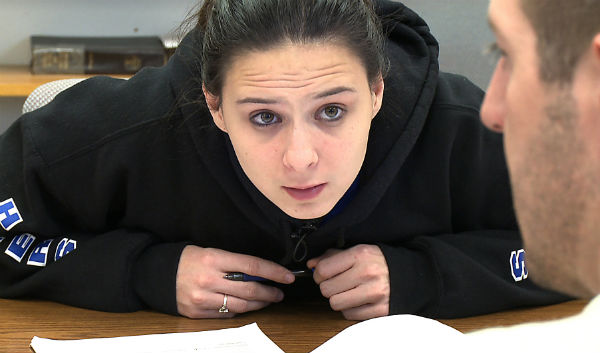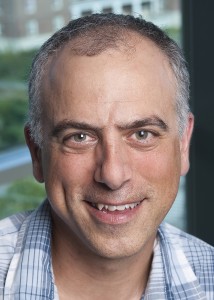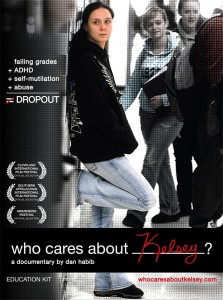
Profiles, Videos  Filmmaker Dan Habib[/caption]
Dan Habib: I began the process of making this film by pursuing several central questions: What does it look like when kids with emotional/behavioral disabilities are well supported and included in school? Can an emotional or behavioral disability grow out of traumatic events of childhood? Can school discipline be administered in a way that is positive and not punitive?
Kelsey was a perfect subject for the film in part because she is funny, honest, comfortable in front of the camera and willing to share very difficult details of her life.
When she entered Somersworth (NH) High School as a freshman, Kelsey was a more likely candidate for the juvenile justice system than graduation. She has a diagnosis of ADHD and carried the emotional scars of homelessness and substance abuse, as well as the actual scars of repeated self-mutilation. Throughout middle school and her early high school years, Kelsey was volatile, disruptive and, by her own admission, "not a nice person" to be around. As a freshman, she didn't earn a single academic credit and was suspended for dealing drugs.
Filmmaker Dan Habib[/caption]
Dan Habib: I began the process of making this film by pursuing several central questions: What does it look like when kids with emotional/behavioral disabilities are well supported and included in school? Can an emotional or behavioral disability grow out of traumatic events of childhood? Can school discipline be administered in a way that is positive and not punitive?
Kelsey was a perfect subject for the film in part because she is funny, honest, comfortable in front of the camera and willing to share very difficult details of her life.
When she entered Somersworth (NH) High School as a freshman, Kelsey was a more likely candidate for the juvenile justice system than graduation. She has a diagnosis of ADHD and carried the emotional scars of homelessness and substance abuse, as well as the actual scars of repeated self-mutilation. Throughout middle school and her early high school years, Kelsey was volatile, disruptive and, by her own admission, "not a nice person" to be around. As a freshman, she didn't earn a single academic credit and was suspended for dealing drugs.
 Who Cares About Kelsey? follows Kelsey through the ups and downs of her senior year, and shows what successful educational approaches look like on the ground, in a real school. And it shows educational reform through the eyes of a student. That’s become increasingly important to me, to make films from a youth-eye view, from the inside looking out.
KW: It seems like this film is a natural “sequel” to your 2009 documentary, Including Samuel, because it involves the transition from childhood into adulthood. Do you consider Who Cares about Kelsey? to be a follow-up to the issues of inclusion that you previously explored, or something completely different?
DH: I’ve personally screened and discussed Including Samuel more than 400 times in the past four years since the film came out. At almost every event, someone asked a variation on this question: ‘What about kids with emotional or behavioral disabilities? Can they be fully included like Samuel?’ The journalist part of my brain thought, ‘If this question keeps coming up, there must be an important story to be told through a film.’ I did some research and read some alarming statistics that motivated me to take on this project. Over two million young people in the United States have an EBD. The Southern Poverty Law Center reports that students with EBD:
Who Cares About Kelsey? follows Kelsey through the ups and downs of her senior year, and shows what successful educational approaches look like on the ground, in a real school. And it shows educational reform through the eyes of a student. That’s become increasingly important to me, to make films from a youth-eye view, from the inside looking out.
KW: It seems like this film is a natural “sequel” to your 2009 documentary, Including Samuel, because it involves the transition from childhood into adulthood. Do you consider Who Cares about Kelsey? to be a follow-up to the issues of inclusion that you previously explored, or something completely different?
DH: I’ve personally screened and discussed Including Samuel more than 400 times in the past four years since the film came out. At almost every event, someone asked a variation on this question: ‘What about kids with emotional or behavioral disabilities? Can they be fully included like Samuel?’ The journalist part of my brain thought, ‘If this question keeps coming up, there must be an important story to be told through a film.’ I did some research and read some alarming statistics that motivated me to take on this project. Over two million young people in the United States have an EBD. The Southern Poverty Law Center reports that students with EBD:
"Who Cares About Kelsey?" A Must See Documentary about Emotional-Behavioral Disability
Documentary filmmaker Dan Habib recently released a new film about a student with Emotional-Behavioral Disability (EBD) and the evidence-based practices that help her achieve a successful transition from high school to adulthood. The documentary Who Cares About Kelsey? examines the serious challenges and surprising triumphs as one student fights against the odds. Mr. Habib's previous film, Including Samuel, portrayed his own family's efforts to include their son in every aspect of family and community life. He has also directed nine mini-films on a variety of educational practices with positive and negative outcomes. I asked Mr. Habib about his documentaries and the message he hopes to convey. Karen Wang: What led you to choose Kelsey as the subject for your film? [caption id="attachment_12909" align="alignright" width="214"] Filmmaker Dan Habib[/caption]
Dan Habib: I began the process of making this film by pursuing several central questions: What does it look like when kids with emotional/behavioral disabilities are well supported and included in school? Can an emotional or behavioral disability grow out of traumatic events of childhood? Can school discipline be administered in a way that is positive and not punitive?
Kelsey was a perfect subject for the film in part because she is funny, honest, comfortable in front of the camera and willing to share very difficult details of her life.
When she entered Somersworth (NH) High School as a freshman, Kelsey was a more likely candidate for the juvenile justice system than graduation. She has a diagnosis of ADHD and carried the emotional scars of homelessness and substance abuse, as well as the actual scars of repeated self-mutilation. Throughout middle school and her early high school years, Kelsey was volatile, disruptive and, by her own admission, "not a nice person" to be around. As a freshman, she didn't earn a single academic credit and was suspended for dealing drugs.
Filmmaker Dan Habib[/caption]
Dan Habib: I began the process of making this film by pursuing several central questions: What does it look like when kids with emotional/behavioral disabilities are well supported and included in school? Can an emotional or behavioral disability grow out of traumatic events of childhood? Can school discipline be administered in a way that is positive and not punitive?
Kelsey was a perfect subject for the film in part because she is funny, honest, comfortable in front of the camera and willing to share very difficult details of her life.
When she entered Somersworth (NH) High School as a freshman, Kelsey was a more likely candidate for the juvenile justice system than graduation. She has a diagnosis of ADHD and carried the emotional scars of homelessness and substance abuse, as well as the actual scars of repeated self-mutilation. Throughout middle school and her early high school years, Kelsey was volatile, disruptive and, by her own admission, "not a nice person" to be around. As a freshman, she didn't earn a single academic credit and was suspended for dealing drugs.
 Who Cares About Kelsey? follows Kelsey through the ups and downs of her senior year, and shows what successful educational approaches look like on the ground, in a real school. And it shows educational reform through the eyes of a student. That’s become increasingly important to me, to make films from a youth-eye view, from the inside looking out.
KW: It seems like this film is a natural “sequel” to your 2009 documentary, Including Samuel, because it involves the transition from childhood into adulthood. Do you consider Who Cares about Kelsey? to be a follow-up to the issues of inclusion that you previously explored, or something completely different?
DH: I’ve personally screened and discussed Including Samuel more than 400 times in the past four years since the film came out. At almost every event, someone asked a variation on this question: ‘What about kids with emotional or behavioral disabilities? Can they be fully included like Samuel?’ The journalist part of my brain thought, ‘If this question keeps coming up, there must be an important story to be told through a film.’ I did some research and read some alarming statistics that motivated me to take on this project. Over two million young people in the United States have an EBD. The Southern Poverty Law Center reports that students with EBD:
Who Cares About Kelsey? follows Kelsey through the ups and downs of her senior year, and shows what successful educational approaches look like on the ground, in a real school. And it shows educational reform through the eyes of a student. That’s become increasingly important to me, to make films from a youth-eye view, from the inside looking out.
KW: It seems like this film is a natural “sequel” to your 2009 documentary, Including Samuel, because it involves the transition from childhood into adulthood. Do you consider Who Cares about Kelsey? to be a follow-up to the issues of inclusion that you previously explored, or something completely different?
DH: I’ve personally screened and discussed Including Samuel more than 400 times in the past four years since the film came out. At almost every event, someone asked a variation on this question: ‘What about kids with emotional or behavioral disabilities? Can they be fully included like Samuel?’ The journalist part of my brain thought, ‘If this question keeps coming up, there must be an important story to be told through a film.’ I did some research and read some alarming statistics that motivated me to take on this project. Over two million young people in the United States have an EBD. The Southern Poverty Law Center reports that students with EBD:
- Have the worst graduation rate of all students with disabilities. Nationally, only 40 percent of students with EBD graduate from high school, compared to the national average of 76 percent.
- Are three times as likely as other students to be arrested before leaving school.
- Are twice as likely as other students with disabilities to live in a correctional facility, halfway house, drug treatment center, or on the street after leaving school.



